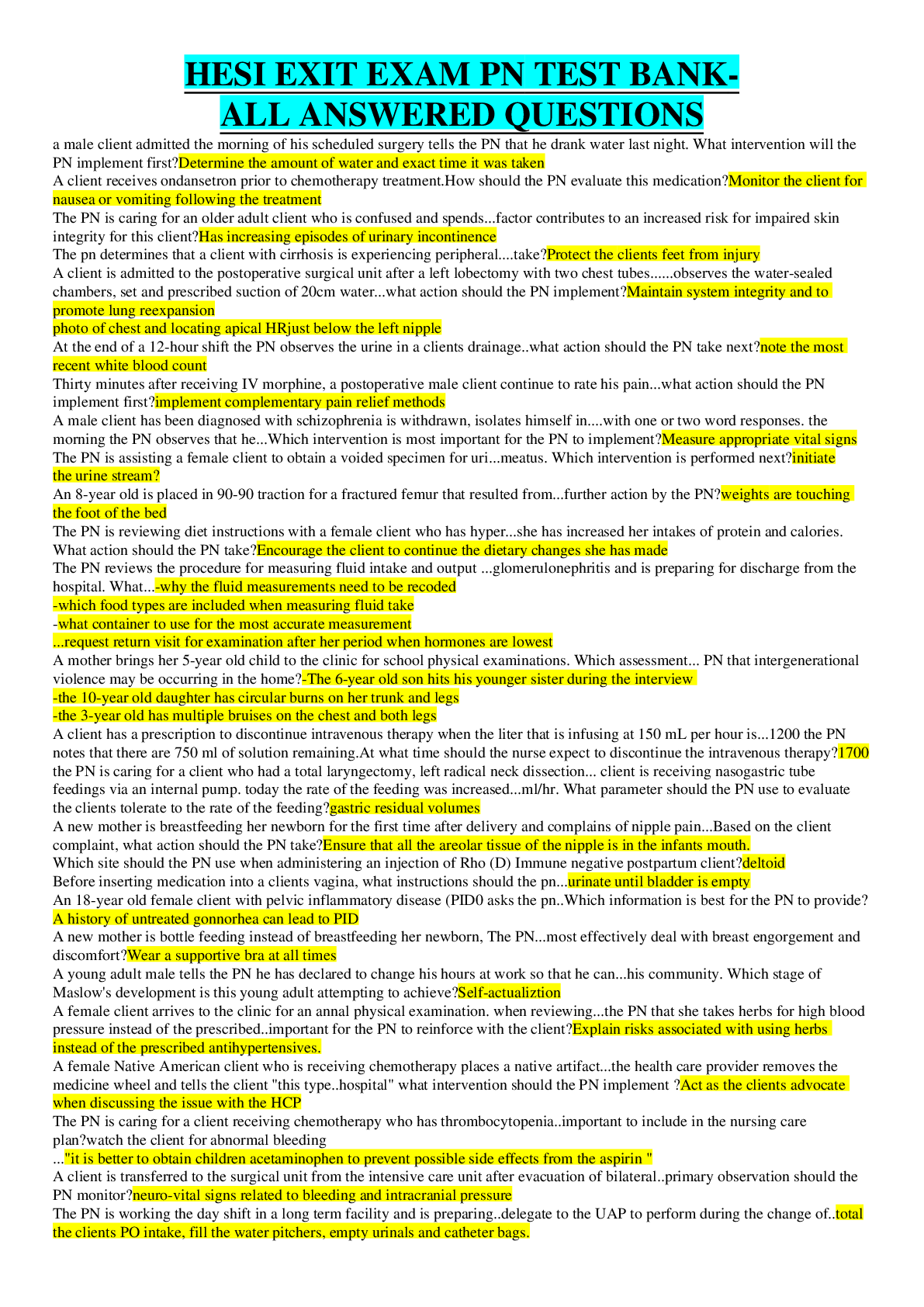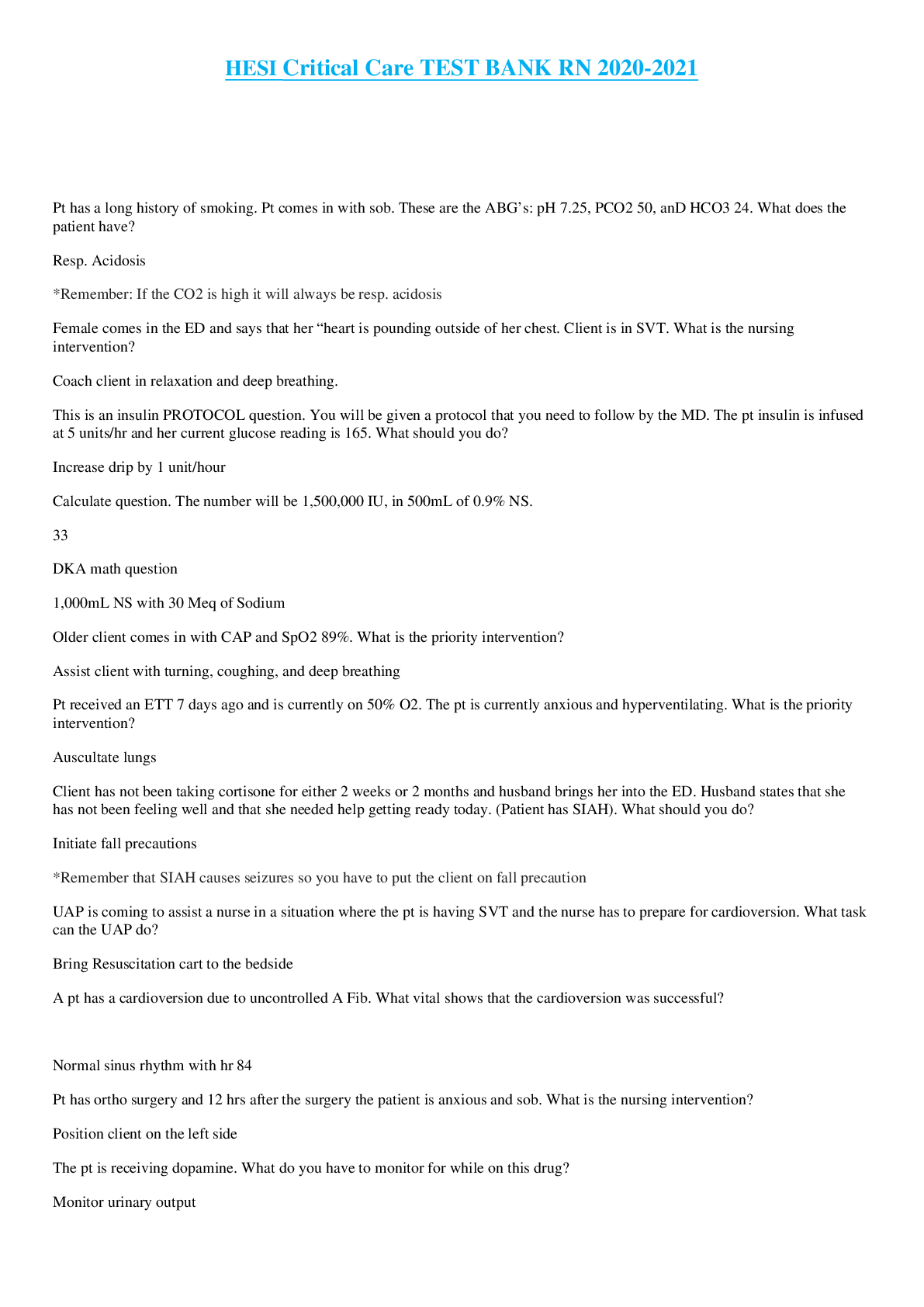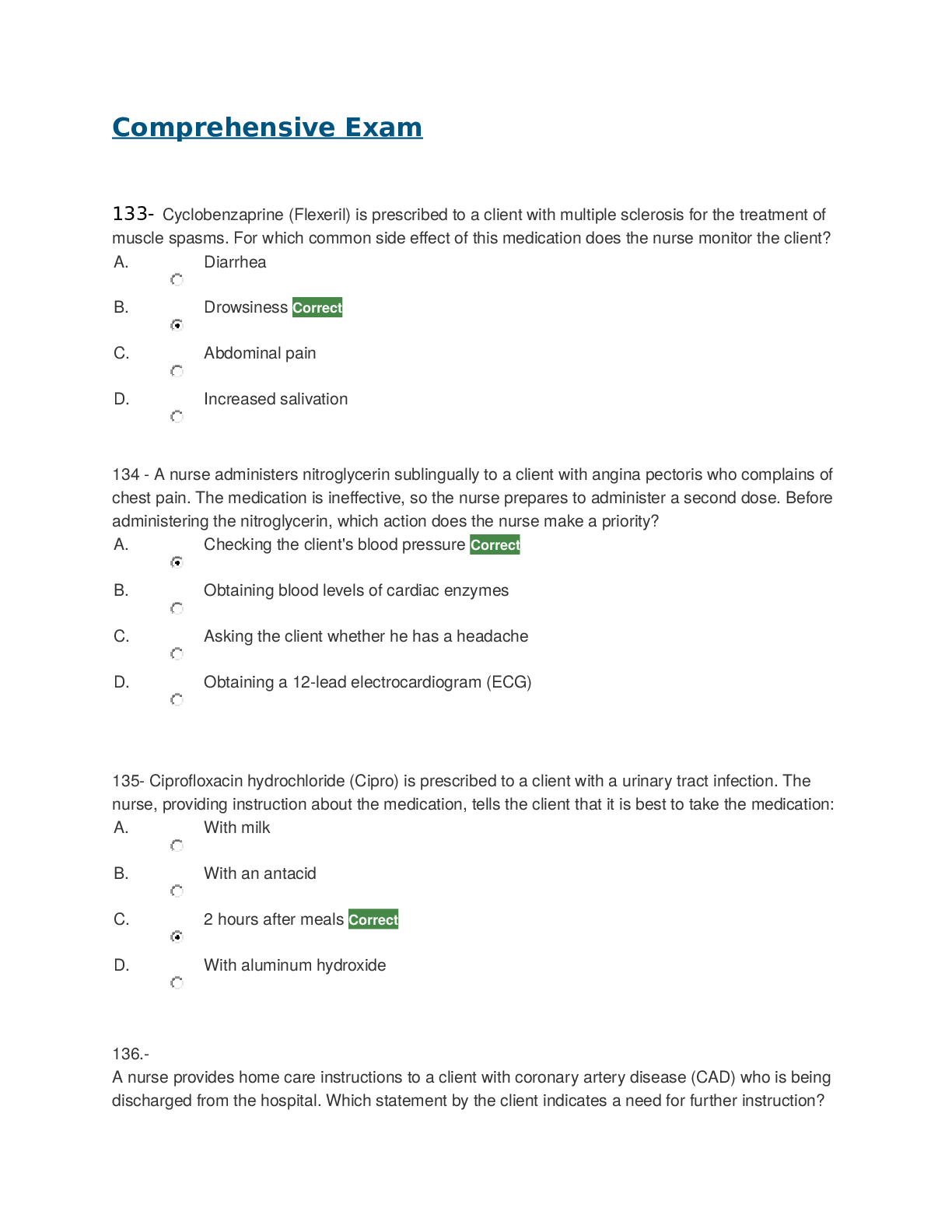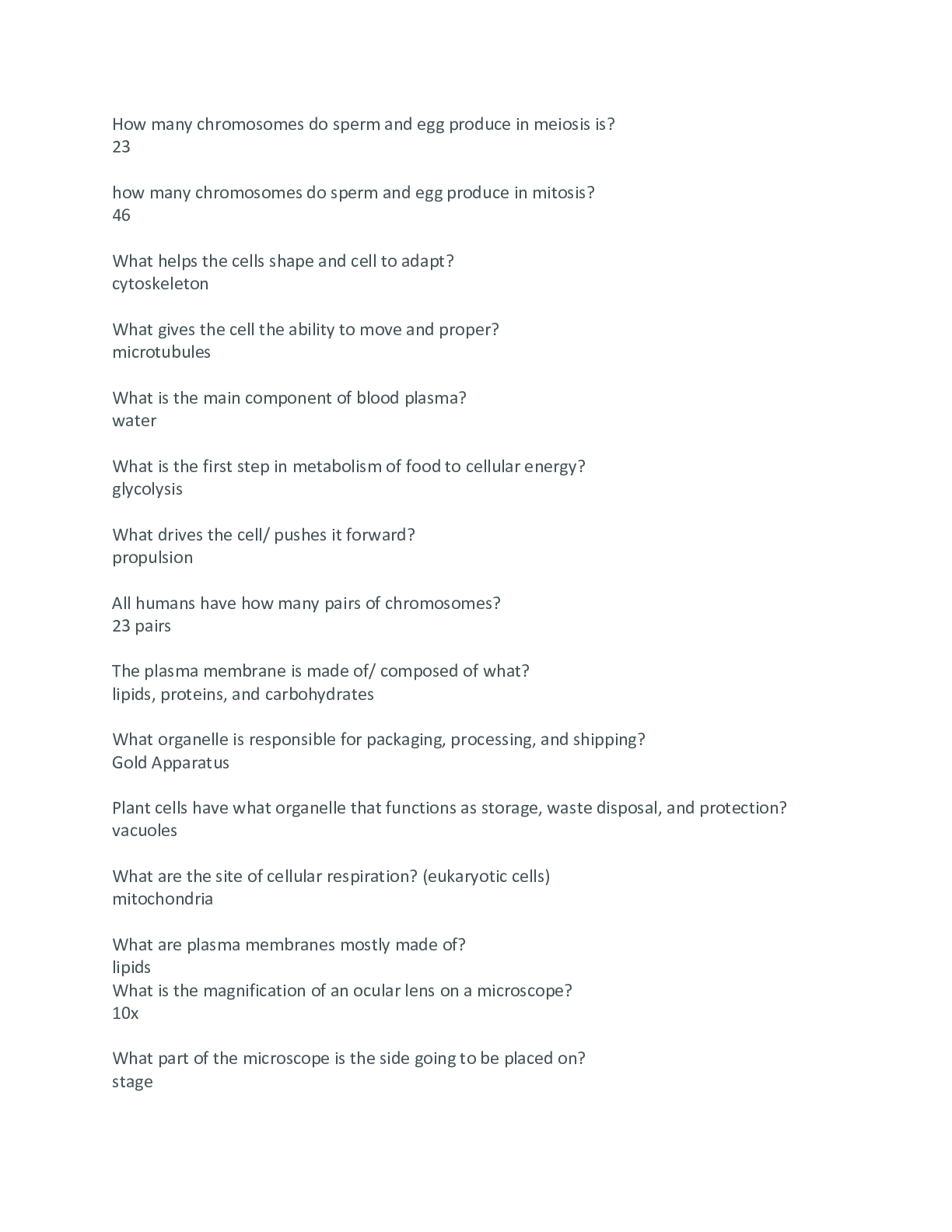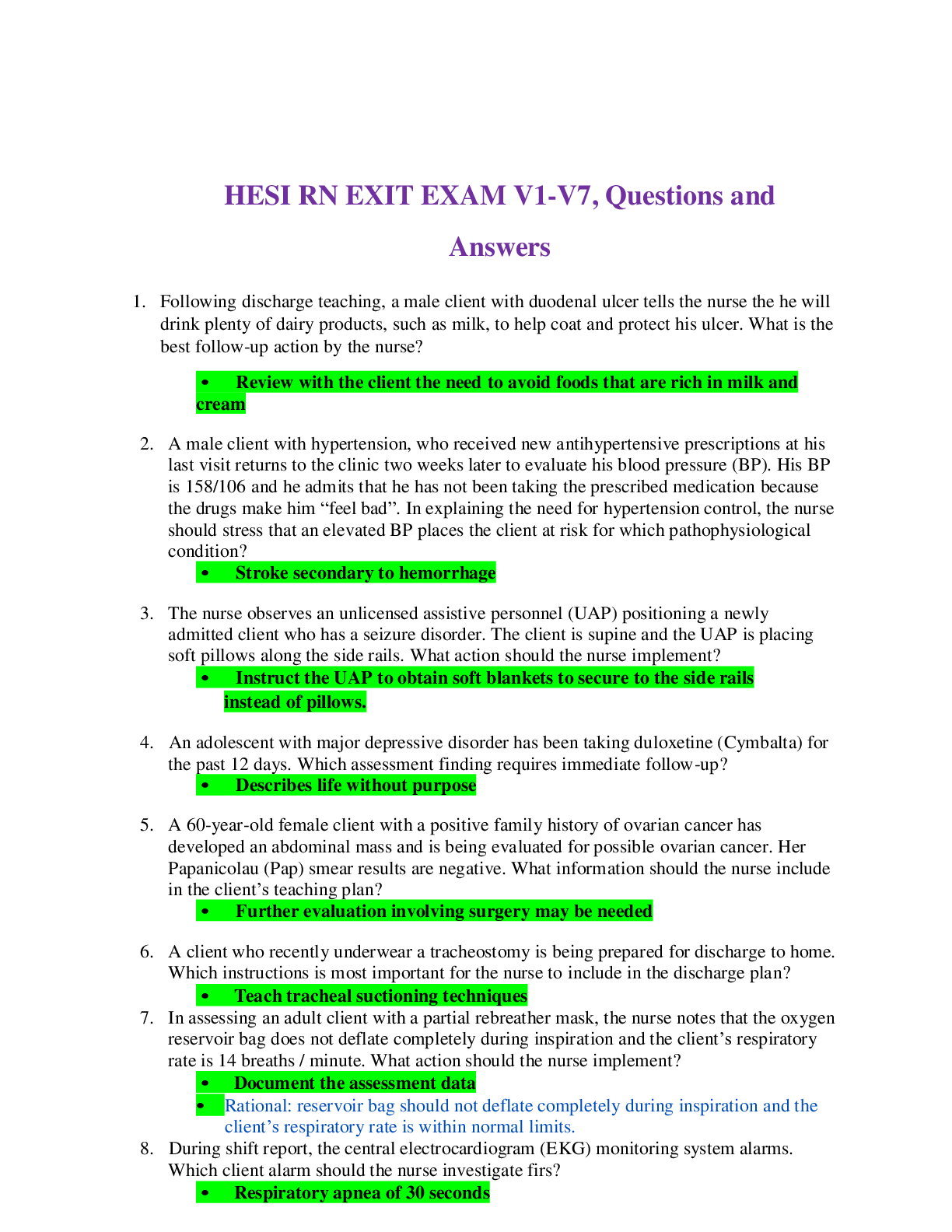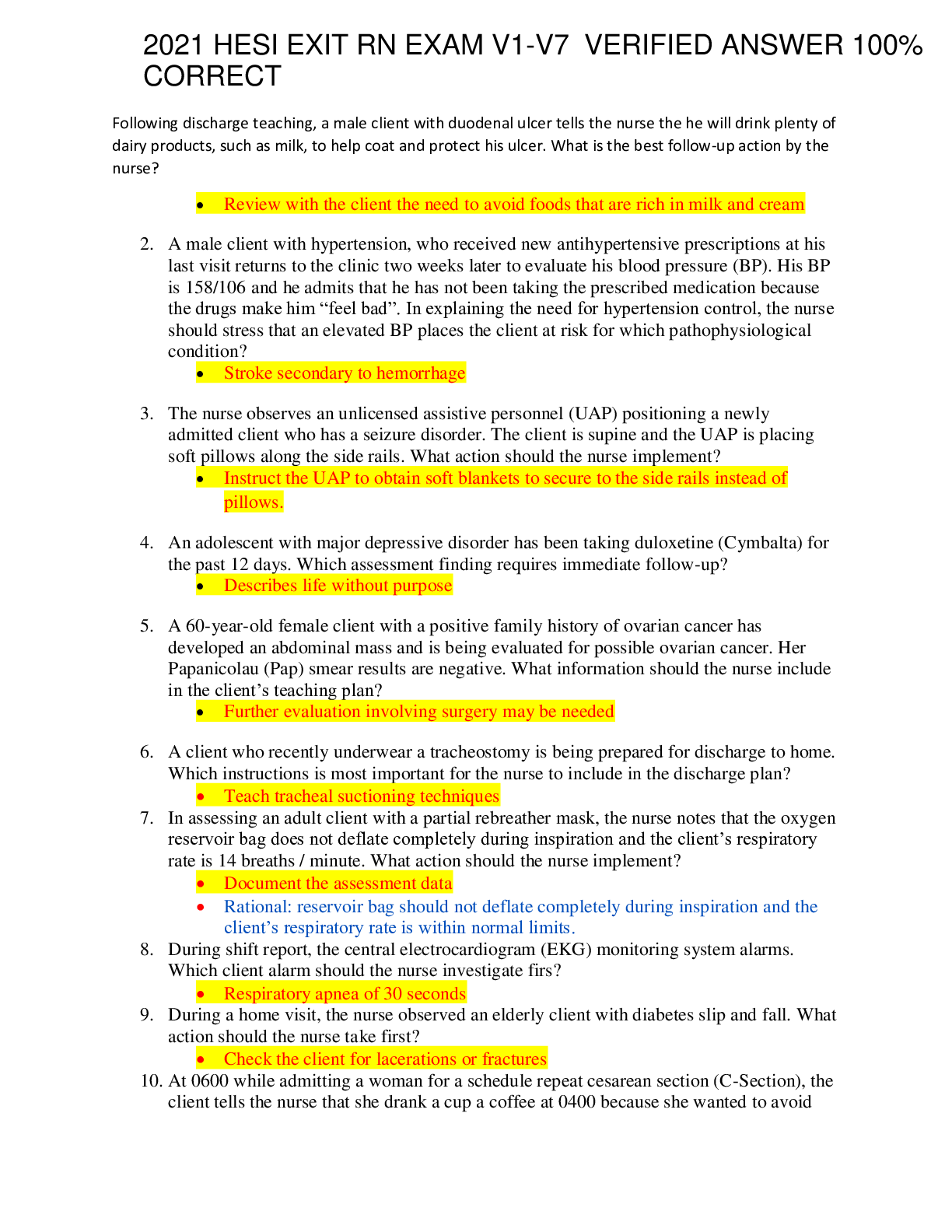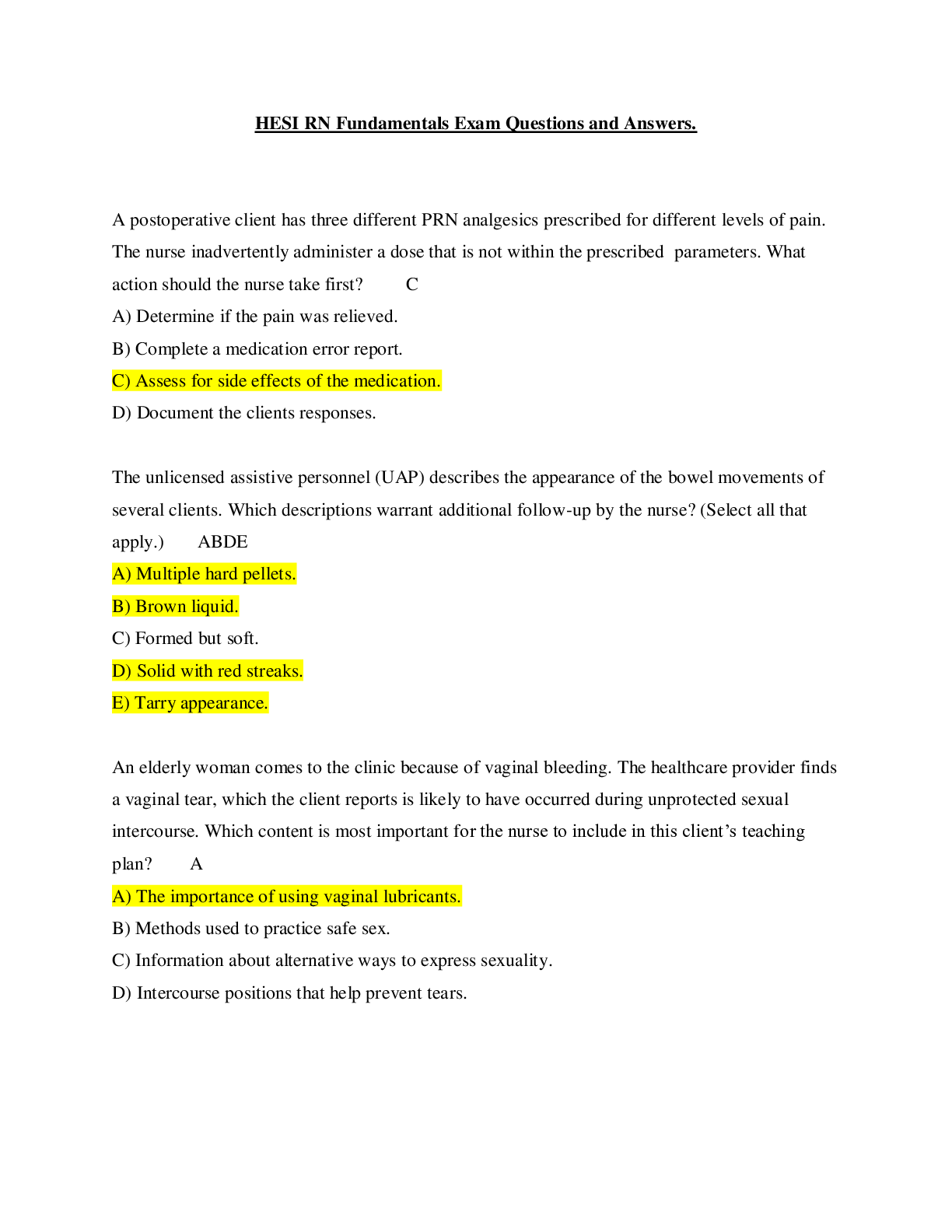*NURSING > HESI > PHARMACOLOGY LVN PHARM7_ Pharmacological & Parenteral Therapies Intensive NCLEX Review. 22Pages of t (All)
PHARMACOLOGY LVN PHARM7_ Pharmacological & Parenteral Therapies Intensive NCLEX Review. 22Pages of the most Comprehensive Solution for NCLEX Preparation.
Document Content and Description Below
Pharmacological & Parenteral Therapies Intensive NCLEX Review PHARMACOLOGICAL AND PARENTERAL THERAPIES • Questions related to pharmacological and parenteral therapies represent 13% to 19% of NCLE... X examination questions MEDICATION ADMINISTRATION • Assessment Guidelines to follow when administering medication to a client: 1. Wash hands before administering medication 2. Assess the 7 rights: a. Right client - ask client to state his name, check identification band b. Right route - the doctor orders the route of administration c. Right drug - verify doctor’s order, the generic & brand name d. Right amount - check dosage, calculation. Assess the need for conversion when preparing a dose of medication e. Right time - administer medication within 30 minutes of prescribed time f. Right Documentation - document the medication given, including the name of the medication, the dosage, the date and time, and your initials (document immediately after giving the medication) g. Right to refuse treatment (Patient’s bill of right) - the patient has the right to refuse treatment 3. Always assess for client allergies or hypersensitivity to a medication. 4. Always assess the client for existing medical disorders that are contraindicated with the administration of a prescribed medication. 5. Always check the client’s vital signs, particularly if medications such as antihypertensive or cardiac medications are being administered. 6. Always check pertinent laboratory results. 7. Assess medication order; if there are questions about or inconsistencies in the written order, the person who wrote the order must be contacted immediately and the order verified 8. Always assess the client for intended effects, side effects, adverse effects, or toxic effects of the medication. 9. Always assess the client’s response to the medication. 10. Always assess for potential interactions related to the medication. 11. Identify and address concerns (social, cultural, religious) that the client may have about taking the medication 12. Do not recap needles, and discard needles in appropriate safety containers; use safety devices provided with the syringe, if available 13. Dispose of any unused medication in accordance with agency policy. RIGHT CLIENT • 2 patient identifiers – Name – Birthdate or Medical Record No. • If patient is confused? No wrist band? RIGHT DRUG Components of a Medication Label • Brand (trade) name • Generic name • Dosage • Form of the medication • Expiration date • Lot number • Name of manufacturer Components of a Medication Order • Date and time when order is written • Name of medication to be given • Dosage • Route of administration • Time and frequency of administration • Signature of person writing the order RIGHT ROUTE • Oral - aspiration precaution; administer only when patient is awake and able to swallow; on upright position • Topicals – Rectal – Sublingual – Nasal – Eyes – Ears – On skin • Parenteral – Intravenous (phlebitis vs infiltration) – Intradermal – just below the skin; TB testing, Allergy testing, local anesthetic – IM: ventrogluteal muscle; Z-track – Subcutaneous – under dermis; small amounts, non- irritating volume; Heparin, Insulin • Routes of Administration (by order of fastest to slowest absorption) – Intravenous – Sublingual – Intramuscular – Subcutaneous – Oral RIGHT FORM Solids • Pour tablet or capsule into the medication container's cap, not your hand (medications prepared for unit dosage may be opened at the time of administration in the client's room) • Medications prepared for unit dosage may be opened at the time of administration in the client's room • Scored tablets (those marked for division) may be divided into halves or quarters • Enteric-coated tablets and sustained-released capsules should not be crushed Solutions: Oral Medications • To pour medication accurately using a medicine cup, *hold the cup at eye level, then line up the measure that is needed and pour • Volumes of less than 5 mL are measured with the use of a syringe from which the needle has been removed • A calibrated dropper is used to give medicine to children or for adding small amounts of liquid to water or juice • Do not mix liquids with tablets (or vise versa) in the same container Solutions: Injectables • Ampules, vials or premeasured syringes and cartridges • Some medications become unstable when stored in solution form and are therefore packaged in powder form • Injectable Medications in Powder Form – Powders must be dissolved with sterile diluent before use; usually sterile water or normal saline solution is used. – The process of dissolving is called reconstitution. • Reconstituting a Medication – To reconstitute a medication, first locate the instructions on the label or in the vial's package insert, then read and follow the directions carefully. – The instructions will state the volume of diluent to be used and the resulting volume of the reconstituted medication. – Often the powdered medication adds volume to the solution in addition to the amount of diluent added. – When reconstituting a multiple-dose vial, label the vial with the date and time of preparation, your initials, and the date of expiration; it is also important to label the strength per volume. Rectal Suppository • Place the client in Sims' position • Lubricate the suppository and insert it, pointed end first, through the anal sphincter muscle about 4 inches (2 inches for a child) • Instruct the client to remain in the supine position for 5 to 10 minutes Vaginal Suppository • Place the client in the lithotomy position • Lubricate the suppository and insert it 2 to 3 inches, toward the sacrum • Instruct the client to remain in the supine position for 5 to 10 minutes (offer a perineal pad) Transdermal Patch or Ointment • Remove the old patch or ointment and cleanse the skin • Avoid touching the inside of the patch or the ointment (wear gloves) • Avoid applying to skin with hair • When using ointment, measure out the correct amount on the appropriate paper applicator and tape the paper in place on the skin • Do not rub ointment into the client's skin Inhalation • Instruct the client how to use the inhaler – Shake inhaler well and remove mouthpiece cover – Breathe out through the mouth, expelling air – Place lips securely around the mouthpiece and inhale; push the top of the medication inhaler once while inhaling – Hold the breath for a few seconds, then exhale slowly – If a second inhalation is prescribed, wait 1 to 2 minutes RIGHT METHOD Eye Drops and Ointments • Drops: place medication in the lower conjunctival sac and instruct the client to blink one or two times, then keep the eyes closed for several minutes • Ointment: squeeze a strip about a quarter-inch long (unless otherwise indicated) into the lower conjunctival sac and instruct the client to close his or her eyes for 2 to 3 minutes Ear Drops • Instruct the client to lie on the unaffected side or to tilt the head toward the unaffected side and to remain in this position for 2 minutes after administration Parenteral Medications • Parenteral medications are administered by way of subcutaneous (SC), intramuscular (IM), or intradermal injection or by the intravenous route • Parenteral medications are packaged in ampules, vials, and premeasured syringes and cartridges • Administer NO MORE than 3 mL per IM or SUBQ injection site • Dispose sharps properly • Needle stick Injury precaution • Choose site: abdomen, lateral and anterior aspects of upper arm or thigh, scapular area of back, or upper ventrodorsal gluteal area. Note: Avoid areas of bony prominence, major nerves, and blood vessels. Prefilled Medication Cartridge • The medication cartridge slips into the cartridge holder, which provides a plunger for injection of the medication • Designed to provide sufficient capacity to permit addition of a second medication when combined dosages are prescribed • Standard medication doses for adults are to be rounded to the nearest tenth (0.1) of a milliliter (a.k.a. "Cubic centimeter" or "cc”) • When a volume greater than 3 mL is required, a 5-mL syringe may be used; this syringe is calibrated in fifths Tuberculin Syringe • Holds a total capacity of 1 mL (1 cc) and is used to measure small or critical amounts of medication (e.g., an allergen extract or vaccine or a child's medication) • May also be used to inject medication intradermally for diagnostic testing (Mantoux test) Insulin Syringe • The standard U-100 insulin syringe is used to measure U-100 insulin only • Insulin should not be measured in any other type of syringe • When the insulin order states to combine Regular and NPH insulin, remember "RN": *draw Regular insulin first, then draw the NPH insulin RIGHT TIME • Most commonly ignored medication error • Administer within 30 minutes of scheduled time • Any delay beyond 30 minutes - DOCUMENT!!! NURSING RESPONSIBILITIES: • Standard precaution • Administer only what you prepare • Be familiar with medication • NO meds at the bedside • Evaluate patient response • Document! • Assess for client allergies • Assess the client for existing medical disorders that are contraindicated with a prescribed medication • Check vital signs for antihypertensive or cardiac medications being administered. • Always check pertinent laboratory results. • Assess medication order; if there are questions about or inconsistencies in the written order, the person who wrote the order must be contacted immediately and the order verified • Always assess the client for intended effects, side effects, adverse effects, or toxic effects of the medication. • Always assess the client’s response to the medication. • Always assess for potential interactions related to the medication. • Identify and address concerns (social, cultural, religious) about medication • Do not recap needles, and discard needles in appropriate safety containers • Use safety devices provided with the syringe • Dispose of any unused medication • DO NOT administer expired, tampered, broken medication • HOME MEDICATIONS: send home or give to pharmacy department RIGHT DOSE • KNOW Drug calculation • KNOW IV rate calculation • Double check with another nurse • Call MD if dose is outside the normal calculated range • DO NOT rely on infusion pumps – VERIFY with calculation • Pediatric dose calculated weight-based (KG) DRUG and IV RATE CALCULATION Drug-Measurement Systems Metric System • The basic units of metric measures are the meter (abbreviated m), liter (abbreviated L), and gram (abbreviated g, gm, or Gm) 1 milligram (mg) = 1000 micrograms (mcg) or 0.001 grams (g) 1 g = 1000 mg 1 kilogram (kg) = 1000 g 1 kg = 2.2 pound (lb) 1 Liter (L) = 1000 milliliters (mL) Apothecary and Household Systems • The four apothecary measures used are grain (abbreviated gr), minim, dram, and ounce (abbreviated oz) • The three household measures commonly used are tablespoon (T), teaspoon (t), and drop (gtt) gr 1 = 60 mg gr 5 = 300 mg gr 15 = 1000 mg or 1 g gr 1/150 = 0.4 mg 1 oz = 30 mL 1 quart (abbreviated "qt") = 1000 mL or 1 L 1 pint (abbreviated "pt") = 16 oz 16 oz = 1 lb 1T = 15 mL 1t = 5 mL 15 gtt = 1 mL Additional Common Drug Measures • Milliequivalent (abbreviated mEq) • Unit Conversions Between Metric Units • To convert larger to smaller, multiply by 1000 or move the decimal point three places to the right • To convert smaller to larger, divide by 1000 or move the decimal point three places to the left Calculating the Correct Dosage • Regardless of the source of an error, if a nurse gives an incorrect dose, the nurse is legally responsible for the action • Be sure that all measures are in the same system and that all units are in the same size, converting when necessary; carefully consider the reasonable amount of the medication that should be administered Formulas for Calculating Medication Dosage Basic Formula Ratio and Proportion Intravenous Flow Rate Guidelines • Check an adult's intravenous (IV) line every 30 minutes, a child's every 15 minutes • The nurse should never speed up an IV drip to catch up without an order to do so from the physician • When an IV rate is increased, the nurse should assess the client for increased heart rate, increased respirations, and increased lung congestion, which could indicate fluid overload • IV fluids are most frequently ordered in dosages of milliliters per hour to be administered Formulas for Intravenous Infusion Flow Rate Infusion Time IV Tubing • A standard or macrodrip set is used for routine adult IV administration; depending on the manufacturer and type of tubing, 10, 15, or 20 drops (gtt) will be required to equal 1 mL • A minidrip or microdrip set is used when more exact measurements are needed, such as in intensive care units and pediatric units • In a minidrip or microdrip set, 60 gtt is equal to 1 mL Intravenous Flow Rate Calculating Infusions Ordered by Unit Dosage per Hour • The most common medications that will be ordered by unit dosage per hour and to run by continuous infusion are heparin sodium and Regular insulin • Calculation of these infusions requires a two-step process: 1. Determine the amount of medication per 1 mL; 2. Determine the infusion rate or milliliters per hour Pediatrics: Oral Medications • Most oral pediatric medications are in liquid or suspension form because most cannot swallow a tablet • Solutions may be measured with the use of an oral syringe; if an oral syringe is not available, a hypodermic syringe without the needle may be used • When the volume of an oral liquid is extremely small, it is measured with a calibrated measuring device • Medications in suspension settle to the bottom of the bottle between uses, so thorough mixing is required before the medication is poured; the medication must be administered immediately after measurement • Oral medications are administered with the child sitting upright, head elevated, to prevent aspiration if the child cries or resists • Never pinch the infant or child's nostrils shut when administering medication • Never place medication in a baby's bottle • Draw the required dose of an unpleasant-tasting medication into a small syringe, and place the syringe in the side and toward the back of the infant's mouth; administer the medication slowly, allowing the infant to swallow • Mix liquid medications with less than an ounce of fluid to disguise the taste, if necessary • If a tablet or capsule is administered, check the child's mouth to ensure that it is swallowed; some tablets may be crushed and given in small amounts of pureed food or flavored syrup (enteric- coated tablets, timed-release tablets, and capsules cannot be crushed), if swallowing is a problem Pediatrics: Parenteral Medications Subcutaneous (SC) and Intramuscular (IM) Medications • Medications most often given by way of the SC route are insulin and most immunizations Any site with sufficient subcutaneous tissue (e.g., the lateral aspect of the upper arm, the abdomen, and the anterior thigh) may be used for a SC injection • The safe use of all injection sites is based on normal muscle development and the size of the child; the preferred muscle site for an IM injection in an infant is the *vastus lateralis • Generally, no more than 0.5 (infant) to 2.0 mL (child) is injected per IM or SC site, and the site of injection is rotated if frequent injections are necessary • The usual needle length and gauge for pediatric clients ranges from 0.5 to 1 inch and 22 to 25 gauge • Needle length can also be estimated by grasping the muscle for injection between the thumb and forefinger; half the resulting distance between the thumb and forefinger represents the needle length • Pediatric dosages for SC and IM administration are calculated to the nearest hundredth and measured with a tuberculin syringe Intravenous (IV) Medications • IV medication is diluted for administration • Adding a medication to an IV solution bag and infusing the contents through a primary IV infusion line allows the medication to be administered on a continuous basis • An IV medication may be administered on an intermittent basis in several doses during a 24-hour period • A medication for IV administration is diluted according to the directions accompanying the medication and in accordance with the physician's orders and agency procedures • Infusion time for an IV medication is determined on the basis of the directions accompanying the medication, the physician's orders, and agency procedures • Determine agency procedures related to the volume of flush for peripheral IV lines and for central lines • The flush volume (3-20 mL) must be included in the child's intake; the flush is started after administration of the IV medication is completed and is infused at the same rate as the medication Pediatrics: Calculation of Dosage by Body Weight Conversion of Body Weight • Pounds to Kilograms – 1 kg = 2.2 lb – To convert from pounds to kilograms, divide by 2.2 – Kilograms are expressed to the nearest tenth • Kilograms to Pounds – 1 kg = 2.2 lb – To convert from kilograms to pounds, multiply by 2.2 – Pounds are expressed to the nearest tenth Calculating Daily Dosages • Dosages are expressed in terms of milligrams per kilogram per day, milligrams per pound per day, or milligrams per kilogram per dose • The total daily dosage is usually administered in divided doses (more than one) per day • Express the child's body weight in kilograms or pounds to correlate with the dosage specifications • Calculate the total daily dosage • Divide the total daily dosage by the number of doses to be administered in 1 day Pediatrics: Calculation Based on Body Surface Area • When a dosage recommendation for children specifies milligrams, micrograms, or units per square meter, calculating the dosage involves simple multiplication • When a dosage is specified only for adults, a formula is used to calculate the pediatric dosage from the adult dosage ANSWERING MEDICATIONS QUESTIONS • General guidelines to follow when answering a question regarding medication administration: 1. Medication absorption, distribution, metabolism, and excretion are affected by age and physiological processes; the *older client and the neonate and infant are at greater risk for toxicity than an adult. 2. Many medications are contraindicated in pregnancy and during breast-feeding. 3. Antacids are not usually administered with medication, because the *antacid will affect the absorption of the medication. 4. Grapefruit juice is not usually administered with medication because it contains a substance that will interact with the absorption of the medication. 5. Enteric-coated and sustained-release tablets should not be crushed; also, capsules should not be opened. 6. Nursing interventions always include monitoring for intended effects, side effects, adverse effects, or toxic effects of the medication. 7. Nursing interventions always include client education. 8. The nurse or client should never adjust or change a medication dose, abruptly stop taking a medication, or discontinue a medication. 9. The nurse may withhold a medication if he or she suspects that the client is experiencing an adverse or toxic effect of a medication; the nurse must immediately contact the physician if either of these effects occurs. 10. The client needs to avoid taking any over-the-counter medications or any other medications, such as herbal preparations, unless they are approved for use by the health care provider. 11. The client needs to know how to correctly administer the medication. 12. The client needs to be aware of the side effects of medications and how to check his or her own temperature, pulse, and blood pressure. 13. The client needs to take the prescribed dose for the prescribed length of therapy and understand the necessity of compliance. 14. The client needs to avoid consuming alcohol and to avoid smoking. 15. The client should wear a Medic Alert bracelet if taking medications, such as but not limited to anticoagulants, oral hypoglycemics or insulin, certain cardiac medications, corticosteroids and glucocorticoids, antimyasthenic medications, anticonvulsants, and monoamine oxidase inhibitors. 16. The client needs to follow up with a health care provider as prescribed. Medication Effects • Intended effect – a desirable effect • Side effect – Not a desired effect – Not usually life-threatening – Can usually be alleviated with specific measures • Adverse effect – More severe than a side effect – Always an undesirable effect – Always reported to the health care provider • Toxic effect – medication level in the body exceeds the therapeutic level Medication Names • No MEMORIZING is necessary! • Both generic name and the trade name will appear • Generic name may be unfamiliar to you, but you may recognize the trade name. Example: furosemide (Lasix) • Unfamiliar name of a medication? Try to break the generic or trade name of the medication into parts and use medical terminology to assist in determining the medication action. Example: Metoprolol (Lopressor) lowers (lo) the blood pressure (pressor) • DO NOT try to memorize every side effect and every nursing intervention for every medication. Relate nursing interventions to the side effects of a medication! Example: If a side effect is hypertension, then the associated nursing intervention would be to monitor blood pressure. Commonalities in Medication Names • Examples: – Antidiuretic hormones – most names end with -pressin such as desmopressin (DDAVP) – Beta-adrenergic blockers – most names end with -lol such as atenolol (Tenormin) – Phenothiazines – most names end with -zine such as chlorpromazine (Thorazine) – Sulfonamides – most medications include sulf in their names such as sulfasalazine (Azulfidine) – Thyroid hormones – most medications contain thy in their names such as levothyroxine (Synthroid) PHARMACOLOGY • Anti-infectives - used for treatment of infection – Bactericidals and bacteriostatics – May end in -cin like -mycin – Possible side effects/adverse effects: Ototoxicity Nephrotoxicity Seizures Blood dyscrasias Hypotension Rash • Glucocorticoids - have anti-inflammatory, anti-allergenic, anti- stress effect – Used for replacement therapy, immunosuppressive drug in post transplant, reduce cerebral edema – Ends with -sone or contains -cort – Possible side effects/adverse reaction: Poor wound healing Bruising, petechiae, ecchymosis Hyperglycemia, fluid retention, insomnia, hypertension May cause Cushing's syndrome May cause immunosuppression Cataract for long term use • Antipyretics - lowers fever • Antacids - decrease the hydrochloric acid in the stomach – Calcium and aluminum-based antacids can constipate – Magnesium based antacids can cause diarrhea • Antihistamine - block histamine in allergic reaction – Watch out for: Drowsiness Dry mouth Sedation • Bronchodilators - dilate large air passages, common side effect tachycardia • Anticholinergics - cause the mucous membranes to become dry, example atropine • Mydriatics - dilate the pupils • Miotics - constrict the pupil • Anticoagulants-prevent clot formation by decreasing the Vit. K level; prevent platelet aggregation INFRINGEMENT: The program materials and content provided to the participant by D&D Nursing Educators, Inc. are designed and copyrighted for exclusive use of its program participants only. Therefore, no content or materials from this review program may be copied, reproduced, modified, republished, uploaded, posted, transmitted, or distributed in any form or by any means or for any purpose without D&D Nursing Educators, Inc. prior written permission. Furthermore, the participant is prohibited to reproduce, duplicate, copy, sell, trade, resell or exploit for any commercial purposes, any portion of the program, use of the service, or access to the service. Any unauthorized reproduction (including but not limited to printing), publication, further distribution or public exhibition of the materials provided on the program, in whole or in part, is strictly prohibited and may result to the participant’s non-acceptance in class, denial access on the online testing and legal actions from D&D Nursing Educators, Inc. [Show More]
Last updated: 1 year ago
Preview 1 out of 22 pages
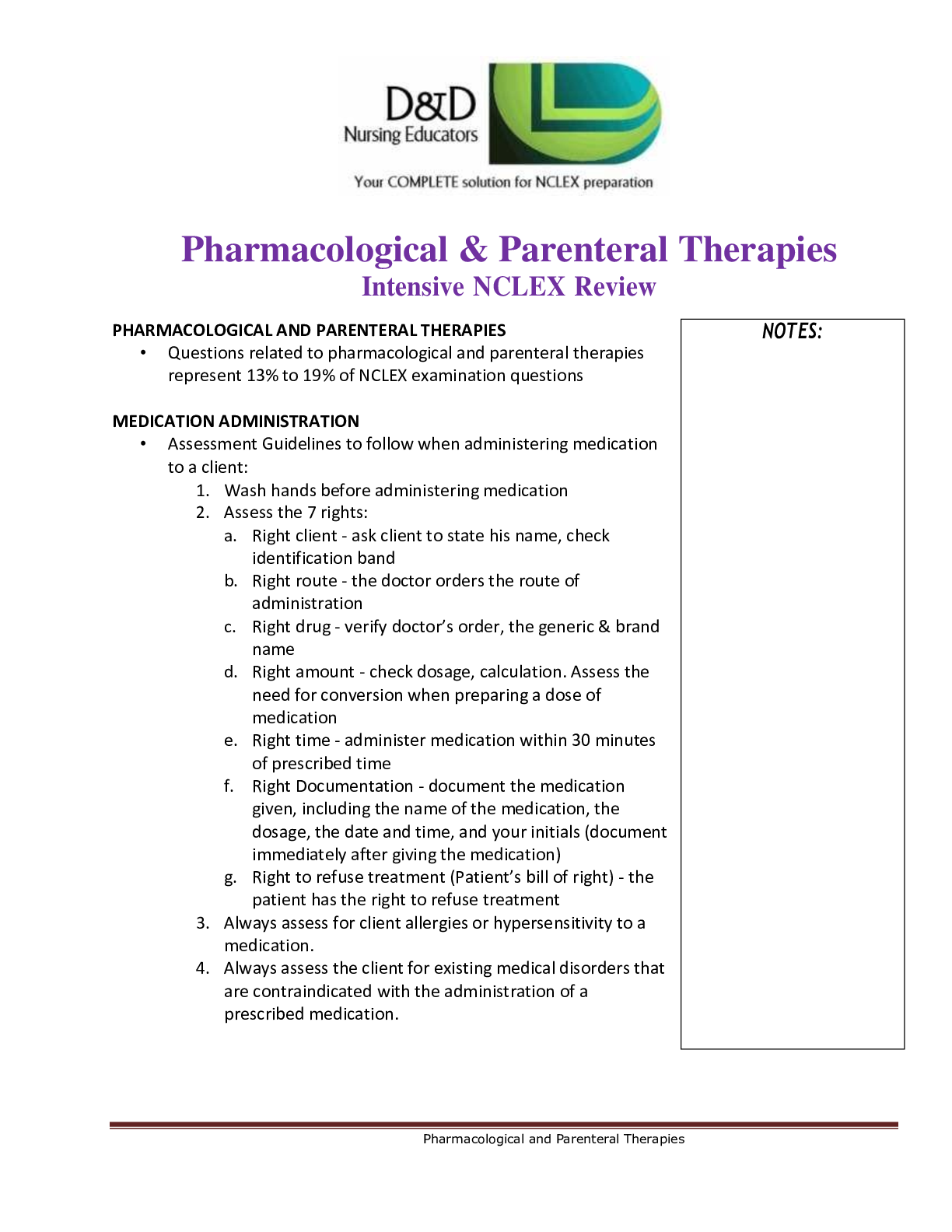
Reviews( 0 )
Document information
Connected school, study & course
About the document
Uploaded On
Apr 22, 2021
Number of pages
22
Written in
Additional information
This document has been written for:
Uploaded
Apr 22, 2021
Downloads
0
Views
75

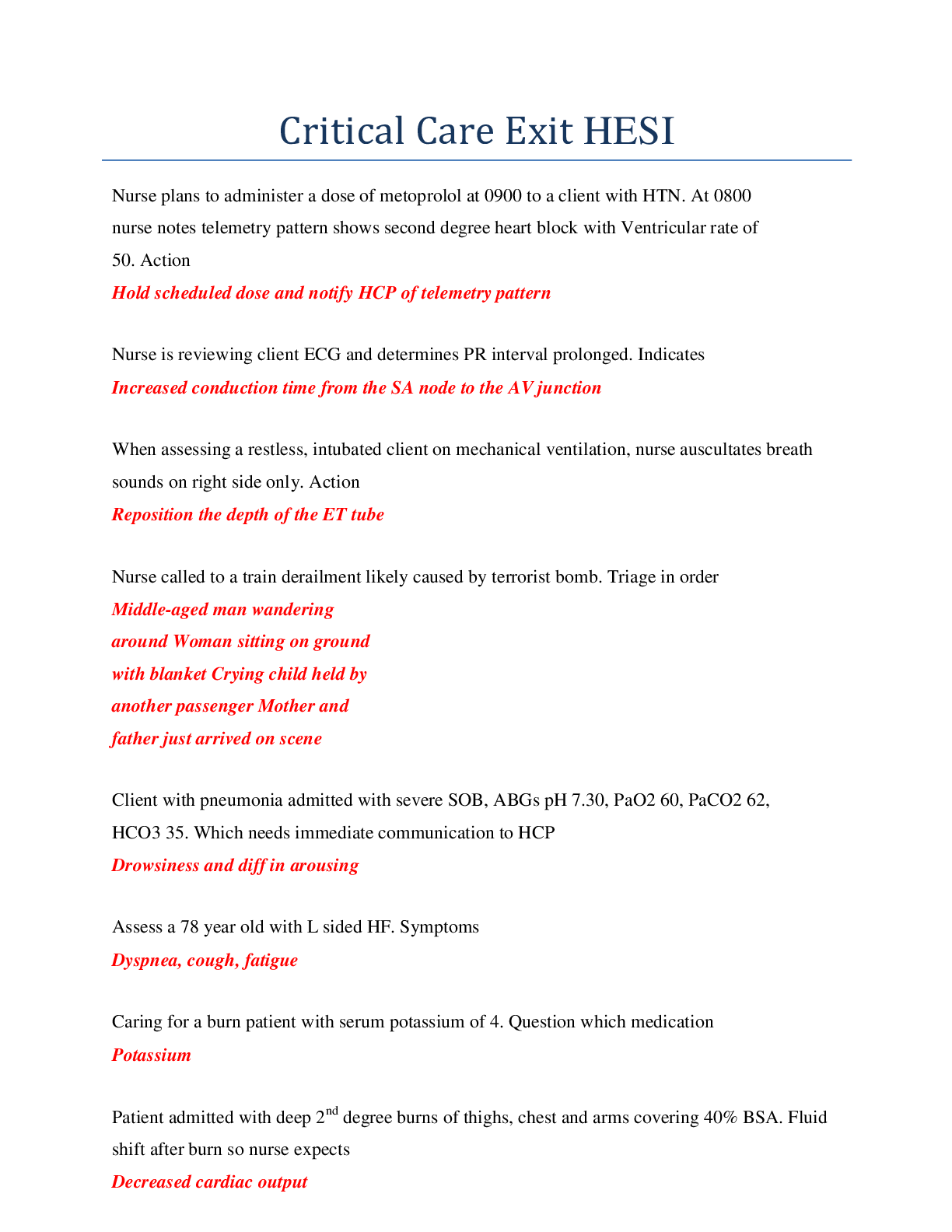
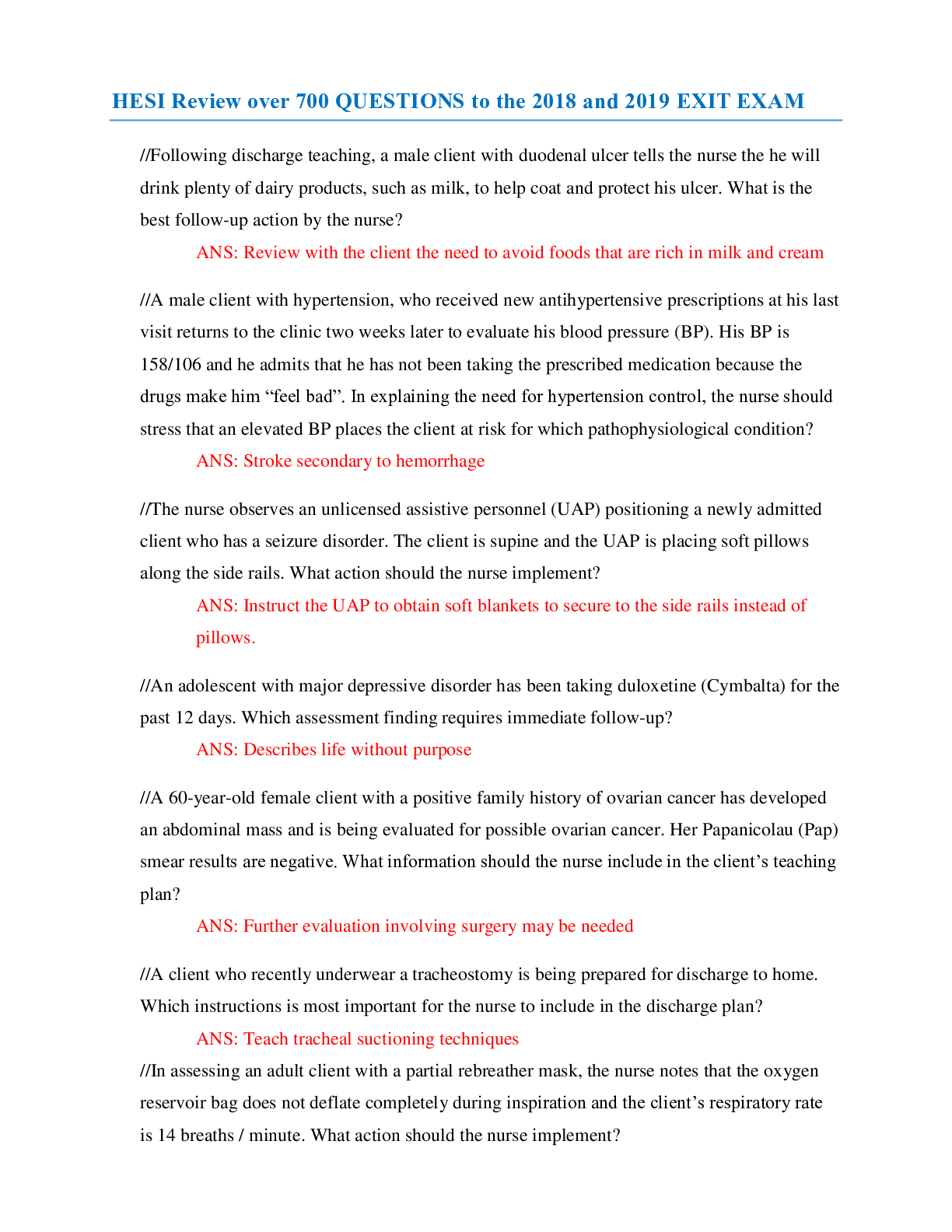
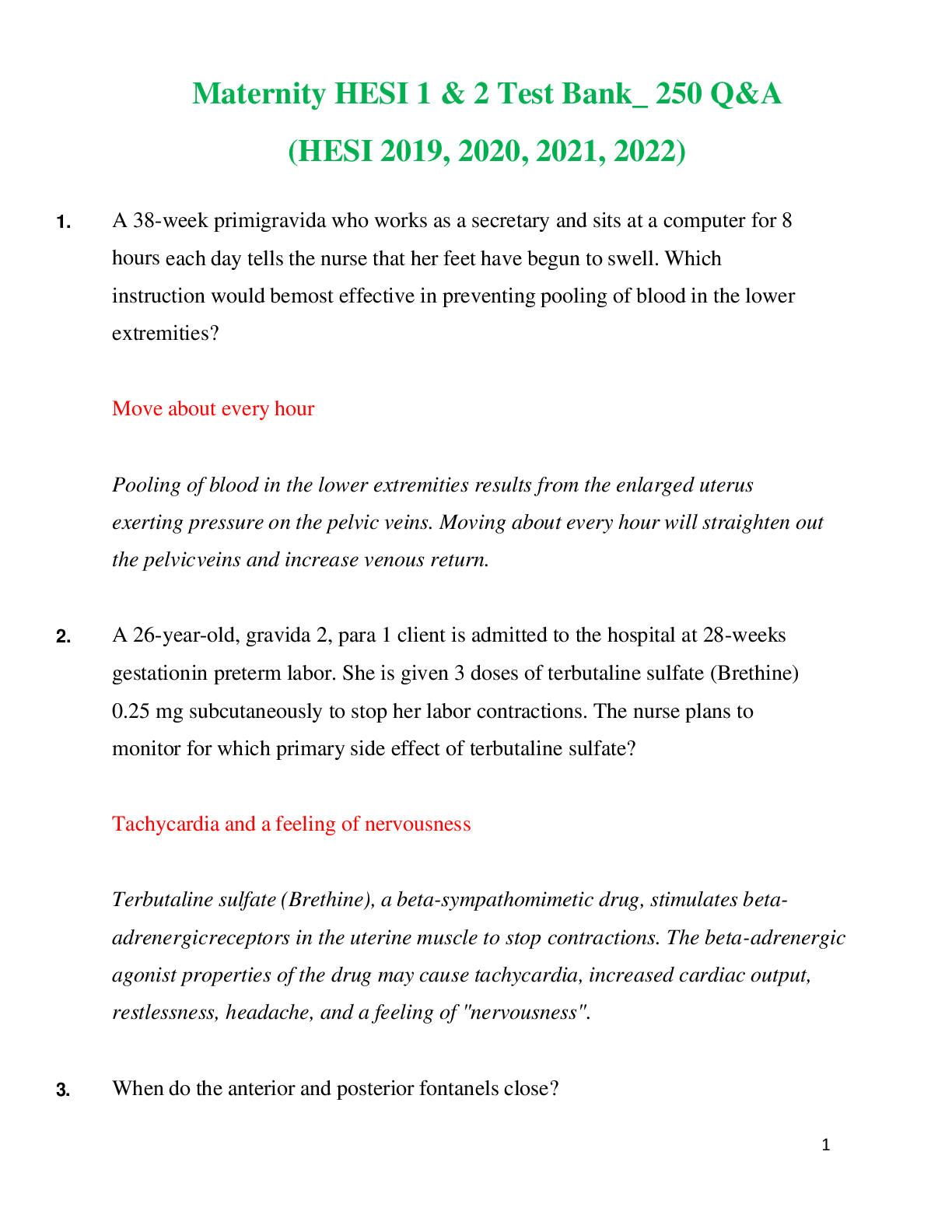
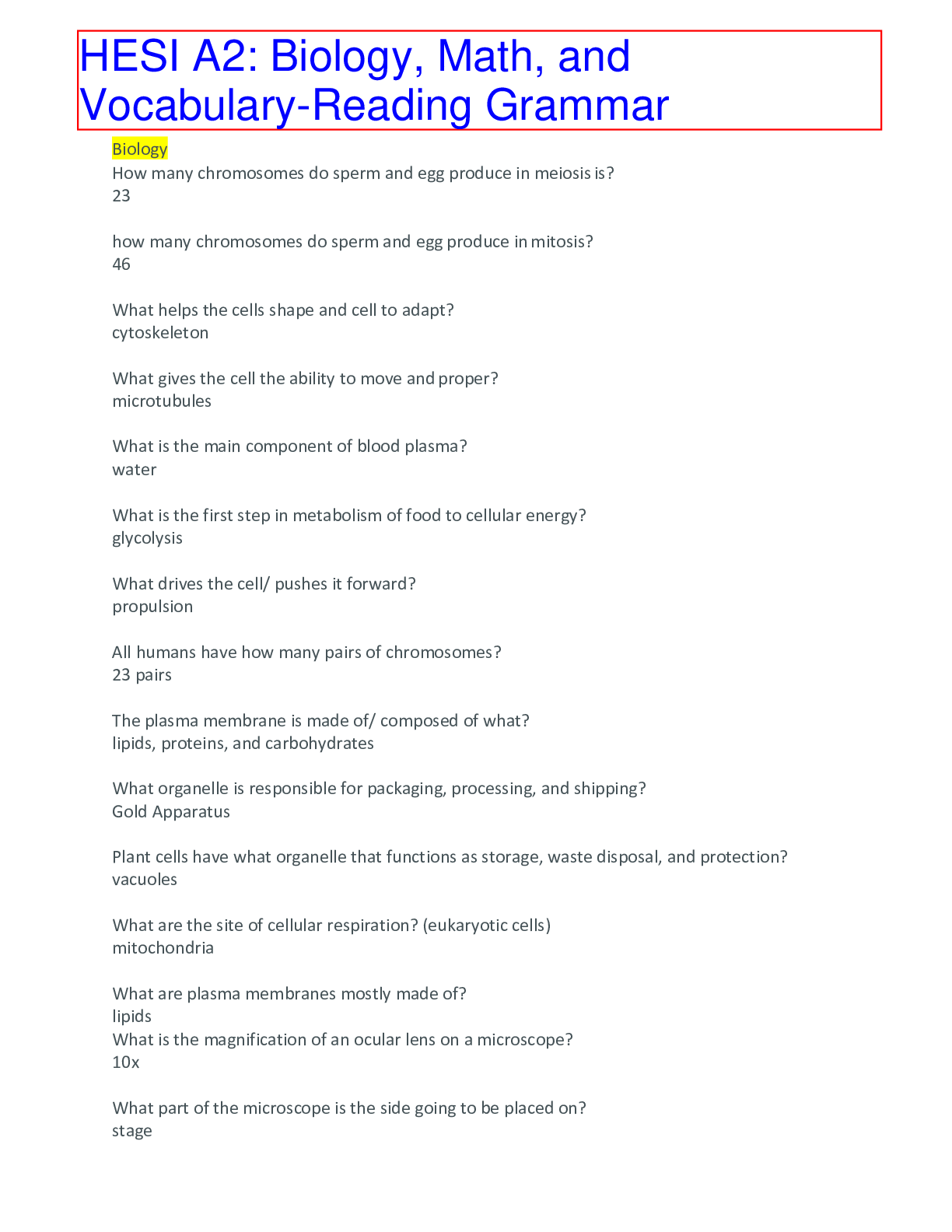
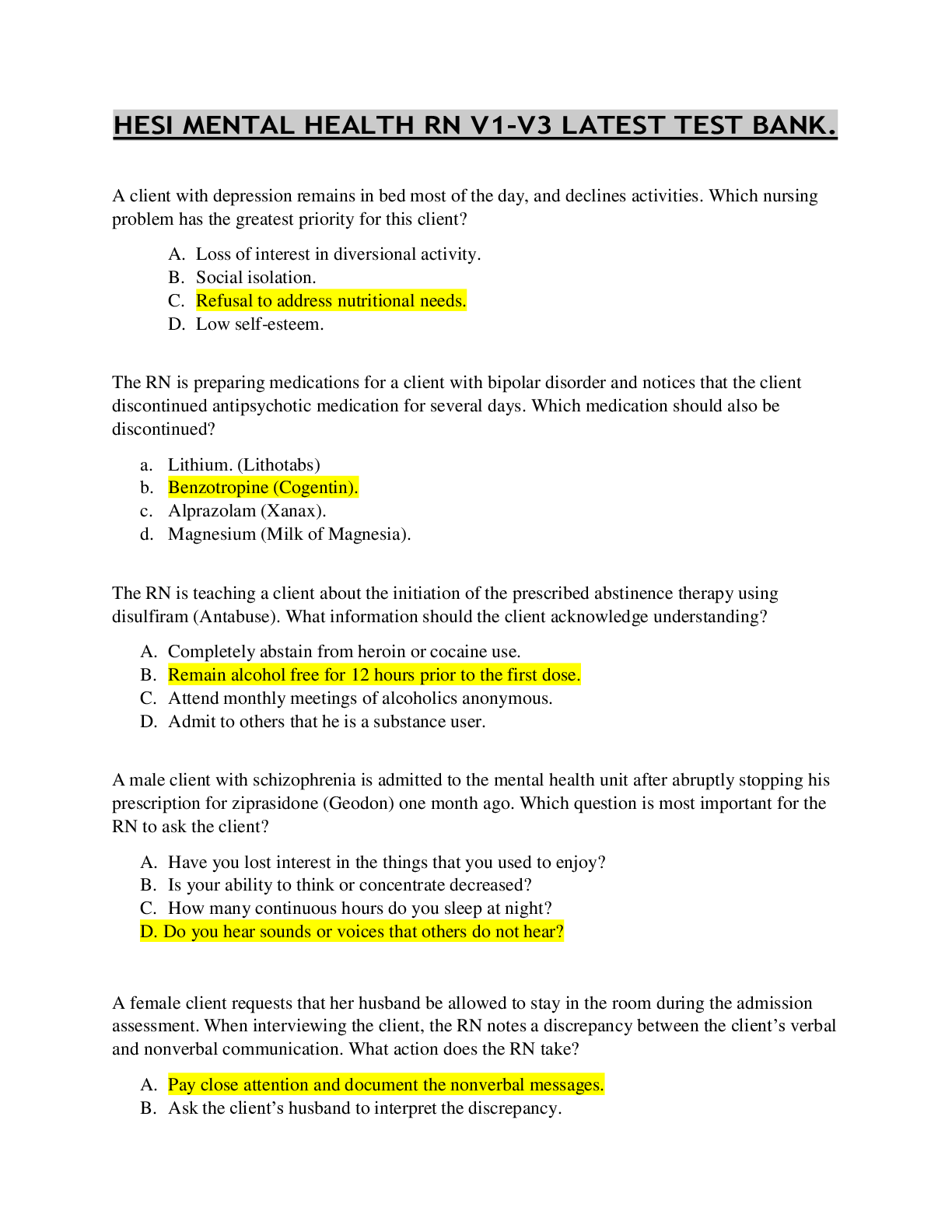
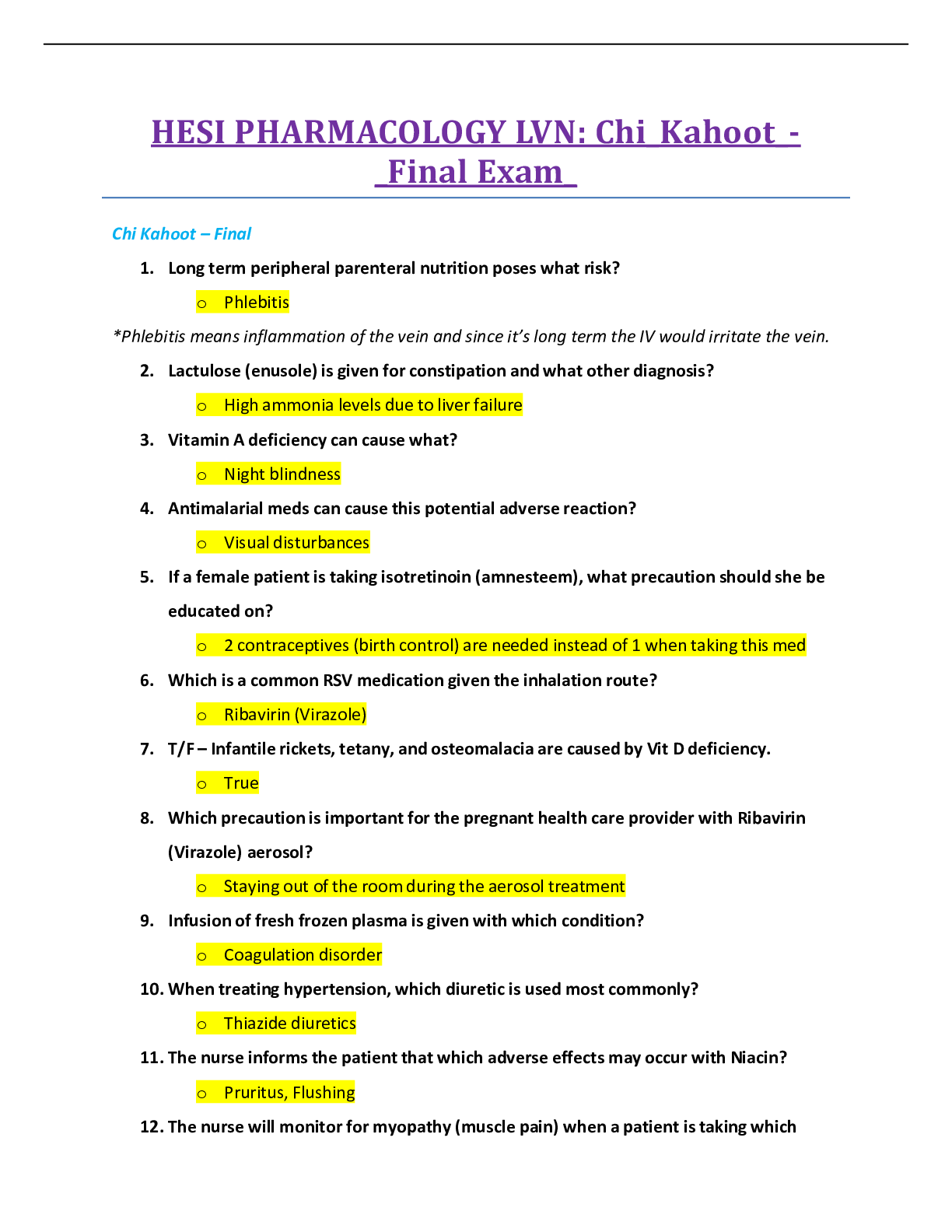
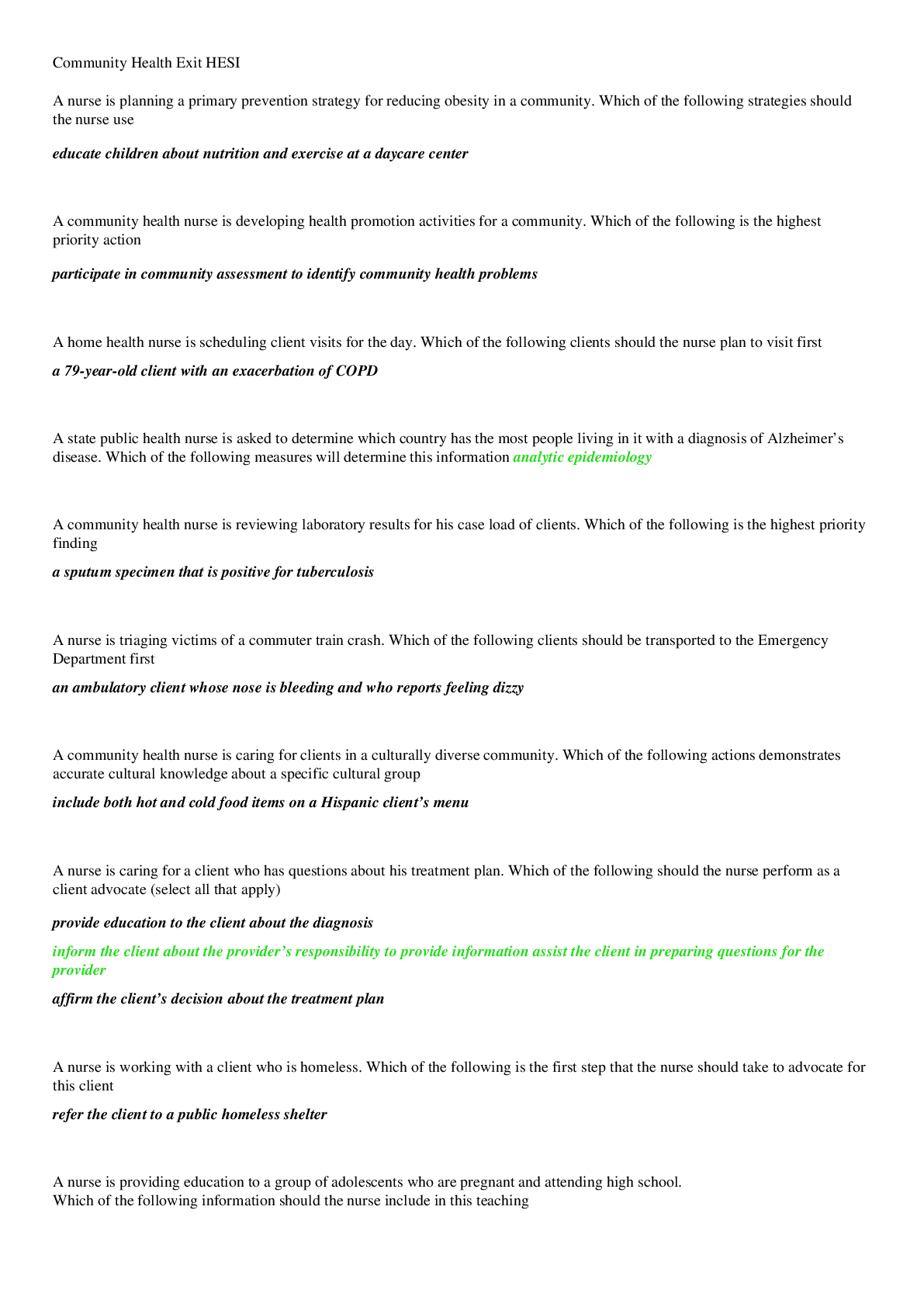
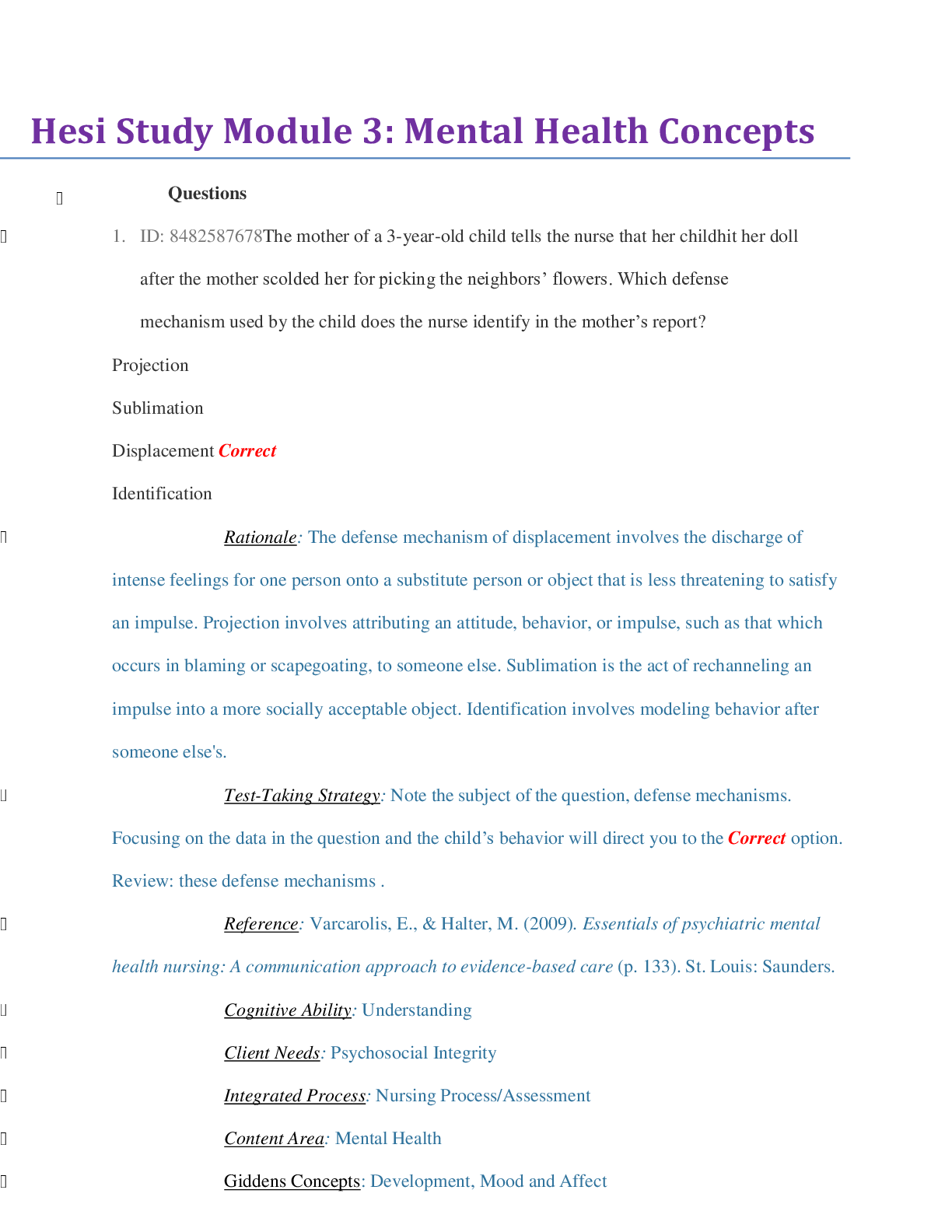
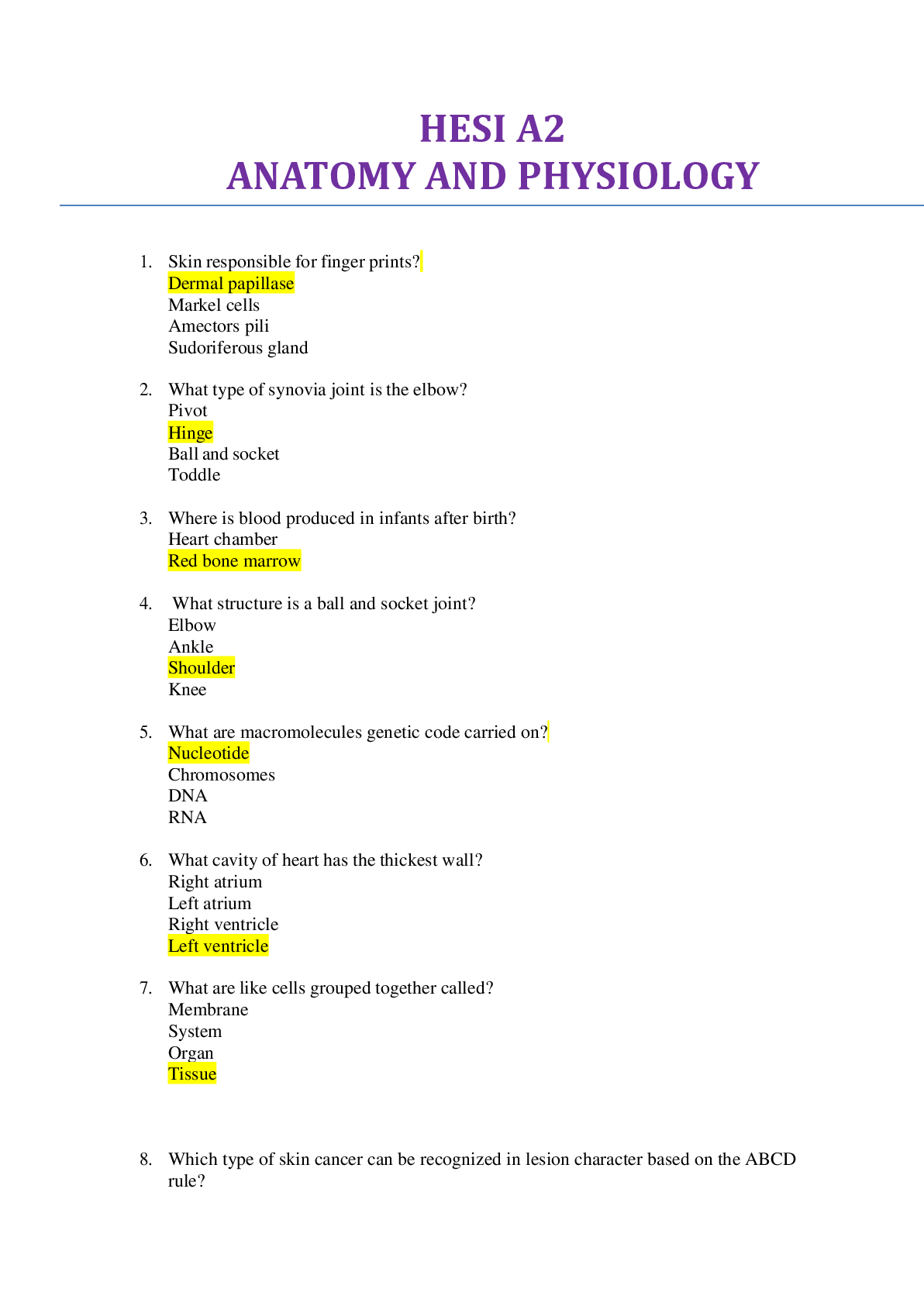
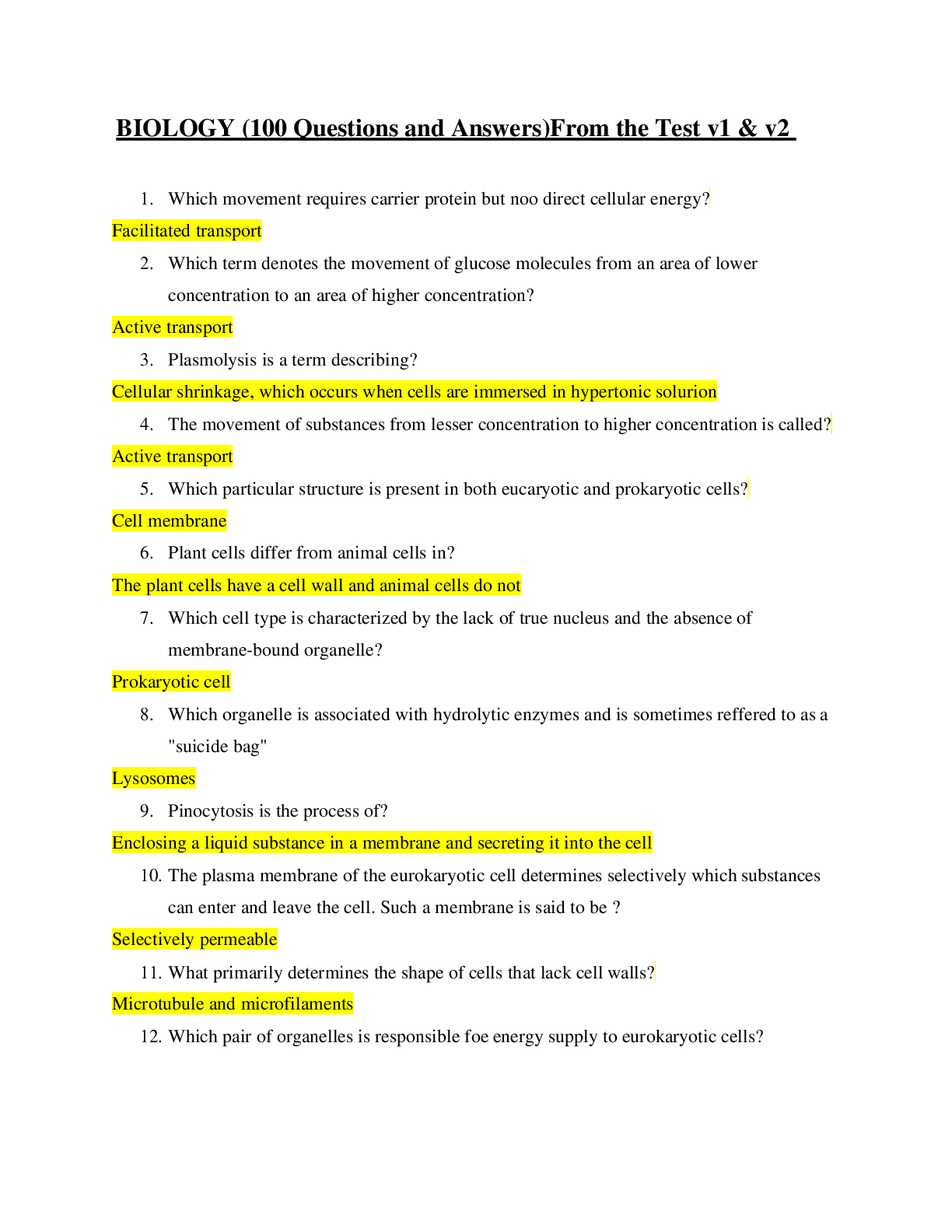
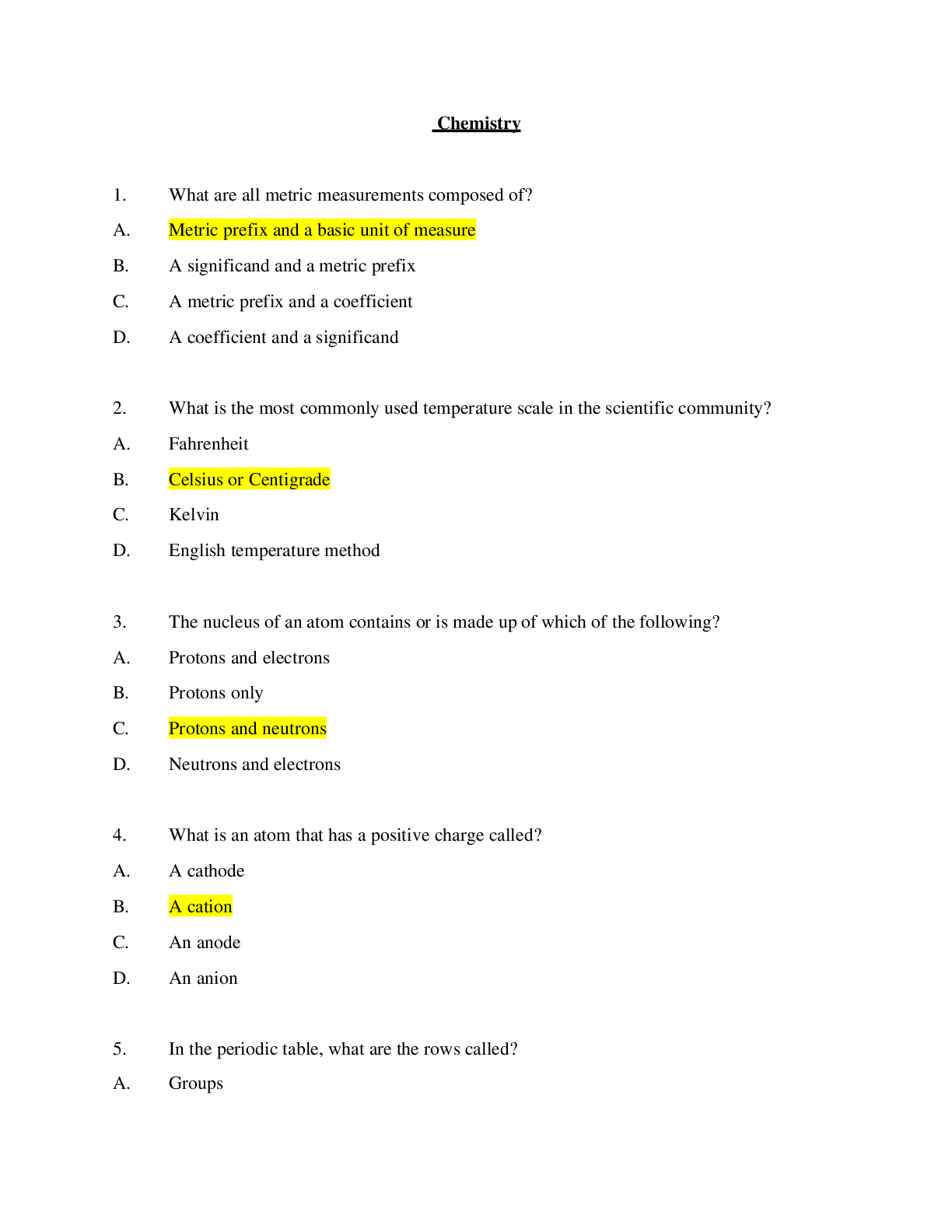
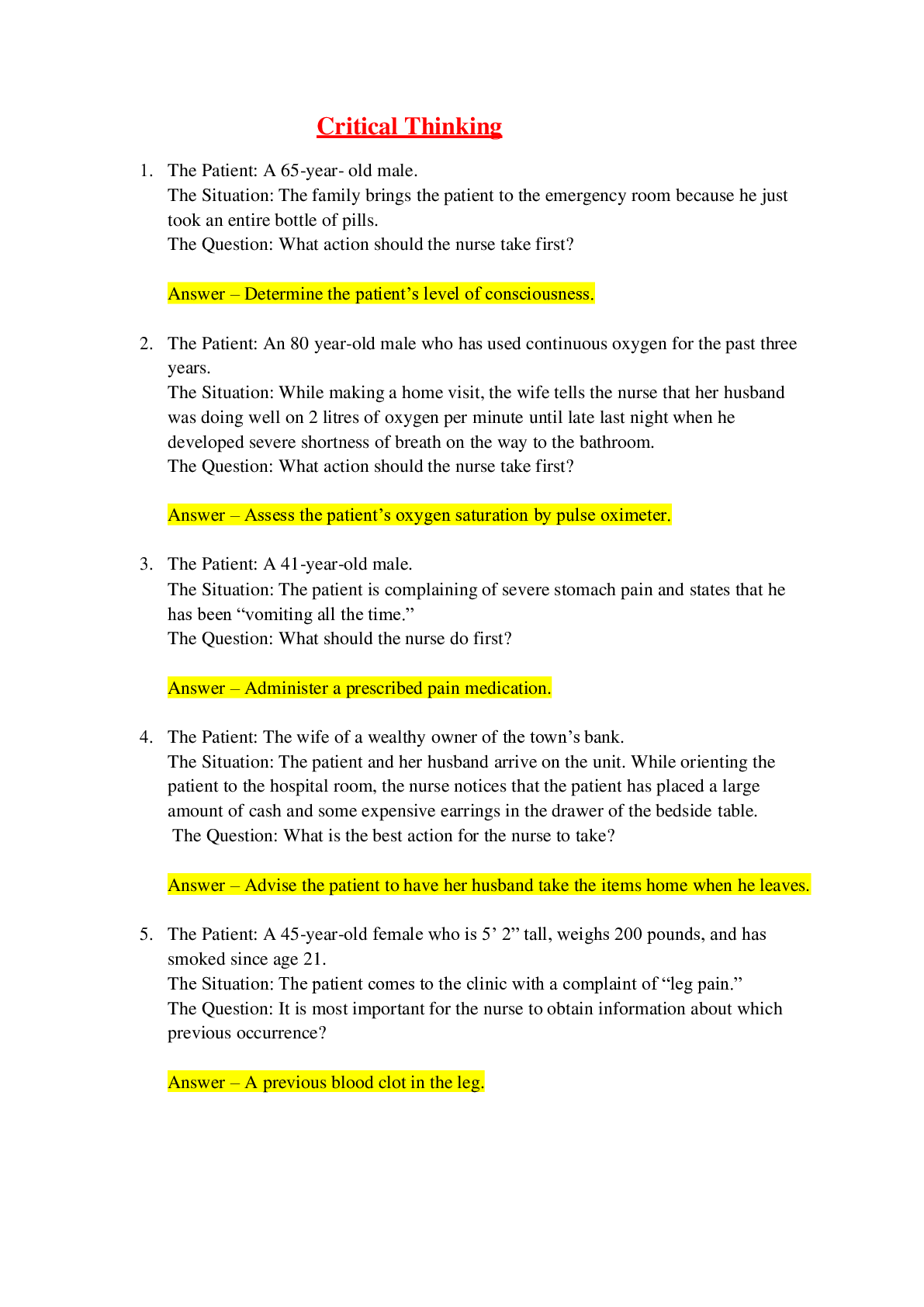
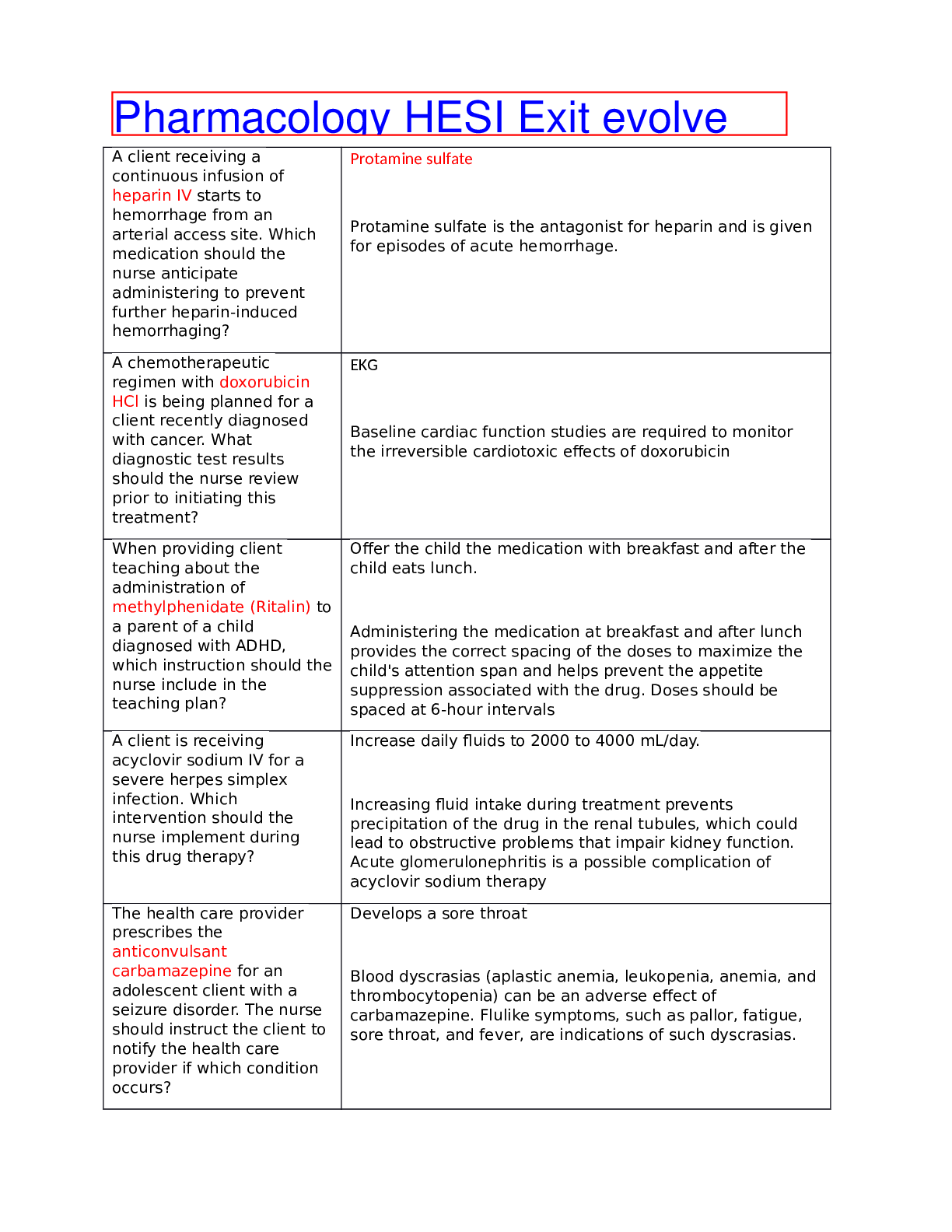
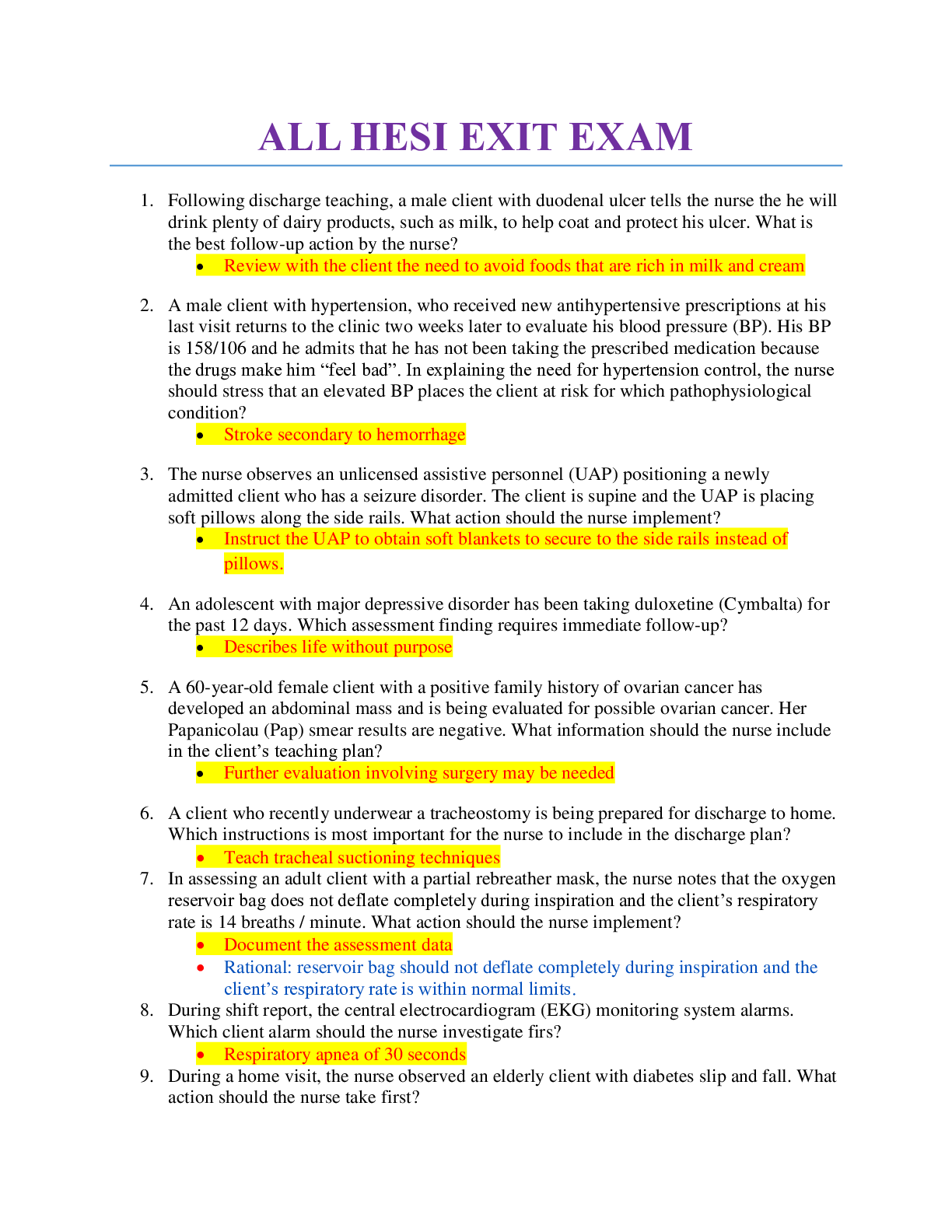

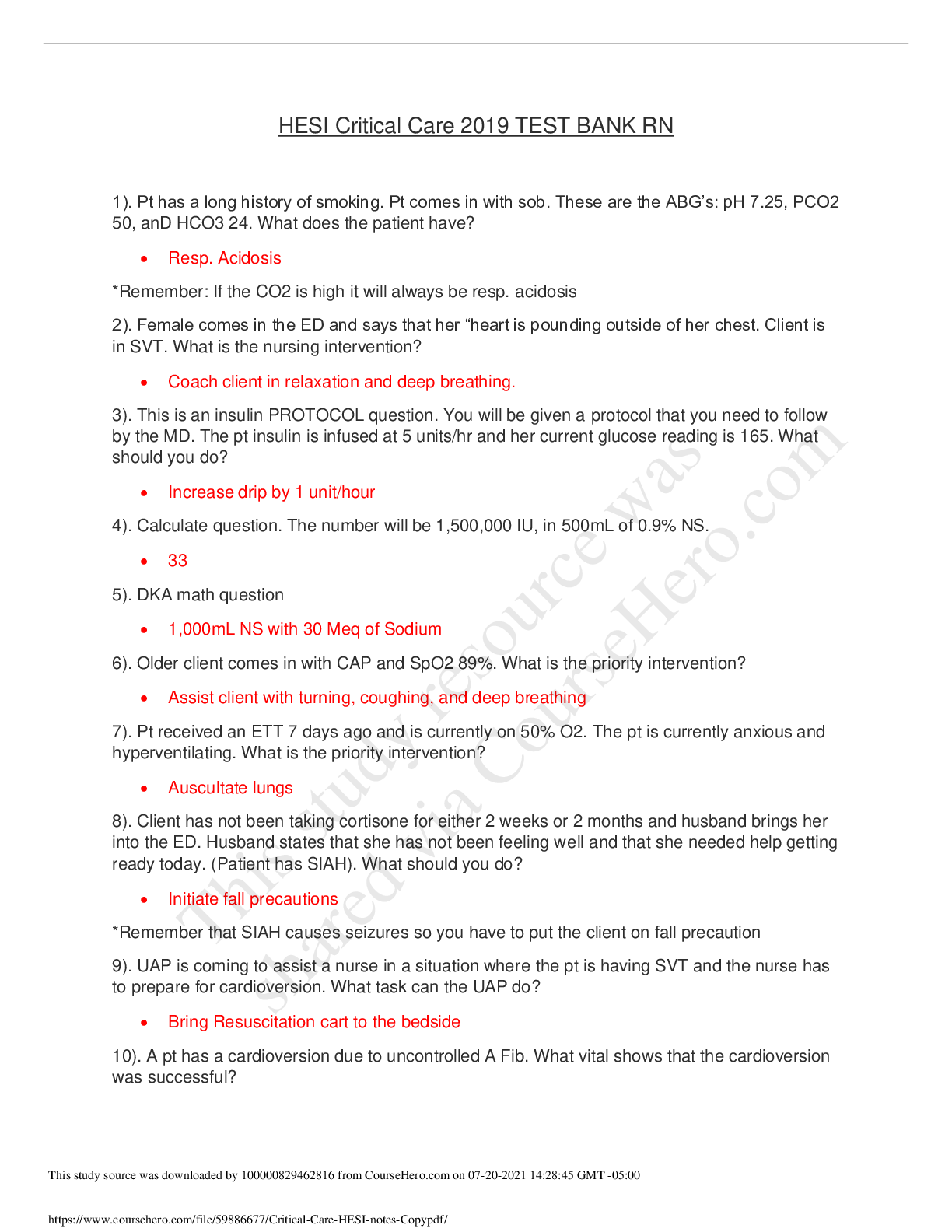
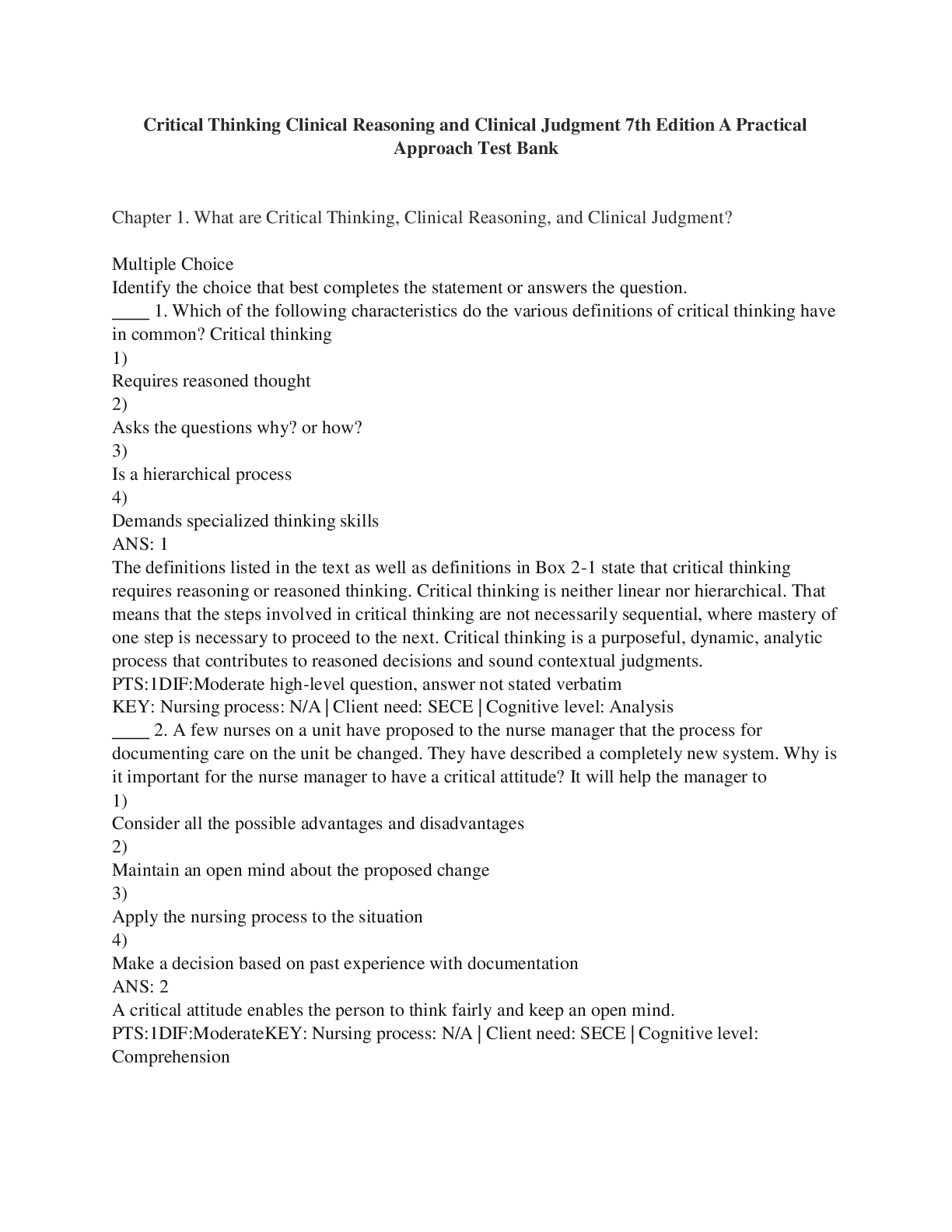





 (1).png)



